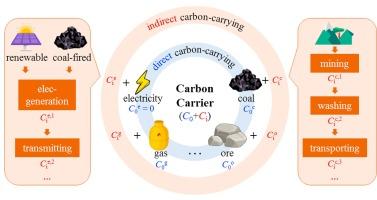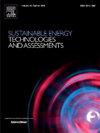用于钢铁行业二氧化碳排放评估的碳载体模型
IF 7.1
2区 工程技术
Q1 ENERGY & FUELS
Sustainable Energy Technologies and Assessments
Pub Date : 2024-11-07
DOI:10.1016/j.seta.2024.104068
引用次数: 0
摘要
钢铁工业的详细碳识别是二氧化碳管理和未来可持续生产的基础。在此,通过碳追踪和碳分配建立了碳载体特征,以识别钢铁制造复杂的能量-质量网中的碳流。对于传统的炼铁和炼钢工艺,如果钢是唯一的产品,则排放强度为 2.33 吨二氧化碳/吨钢。考虑到其他副产品及其碳分配,排放强度将降至 1.11 吨二氧化碳/吨钢,其余分配给林茨-多纳维茨煤气 0.30 吨二氧化碳/吨钢、高炉煤气 0.84 吨二氧化碳/吨钢、焦炉煤气 0.08 吨二氧化碳/吨钢。能量和质量的综合利用有助于降低每种产品的二氧化碳强度。传统工艺的余热回收和设备效率提高可分别减少 ∼16 % 和 ∼15 % 的 CO2。电弧炉炼钢可减少 90% 的二氧化碳。应用碳载体可进行行业碳管理,加速未来的脱碳进程。本文章由计算机程序翻译,如有差异,请以英文原文为准。

Carbon carrier modeled for CO2 emission assessment in steel industry
Detailed carbon identification of steel industry is fundamental for CO2 management and future sustainable production. Herein, Carbon carrier characterized by carbon tracing and assignment is established to identify carbon flow in complexed energy-mass net of steel manufacturing. For traditional iron & steel process, the emission intensity is ∼2.33 t CO2/t steel if steel is the only product. While considering other by-products and their carbon assignment, the emission intensity would be decreased to ∼1.11 t CO2/t steel, with the rest assigned to Linz-Donawitz Gas ∼0.30 t CO2/t steel, Blast Furnace Gas ∼0.84 t CO2/t steel, and Coke Oven Gas ∼0.08 t CO2/t steel. Comprehensive utilization of energy and mass is helpful to reduce CO2 intensity of each product. Waste heat recovery and equipment efficiency improvement of the traditional process can reduce ∼16 % and ∼15 % CO2, respectively. Steel-making by Electric Arc Furnace achieves 90 % CO2 cut-down. With application of Carbon carrier, industry carbon management can be conducted to accelerate future decarbonization.
求助全文
通过发布文献求助,成功后即可免费获取论文全文。
去求助
来源期刊

Sustainable Energy Technologies and Assessments
Energy-Renewable Energy, Sustainability and the Environment
CiteScore
12.70
自引率
12.50%
发文量
1091
期刊介绍:
Encouraging a transition to a sustainable energy future is imperative for our world. Technologies that enable this shift in various sectors like transportation, heating, and power systems are of utmost importance. Sustainable Energy Technologies and Assessments welcomes papers focusing on a range of aspects and levels of technological advancements in energy generation and utilization. The aim is to reduce the negative environmental impact associated with energy production and consumption, spanning from laboratory experiments to real-world applications in the commercial sector.
 求助内容:
求助内容: 应助结果提醒方式:
应助结果提醒方式:


